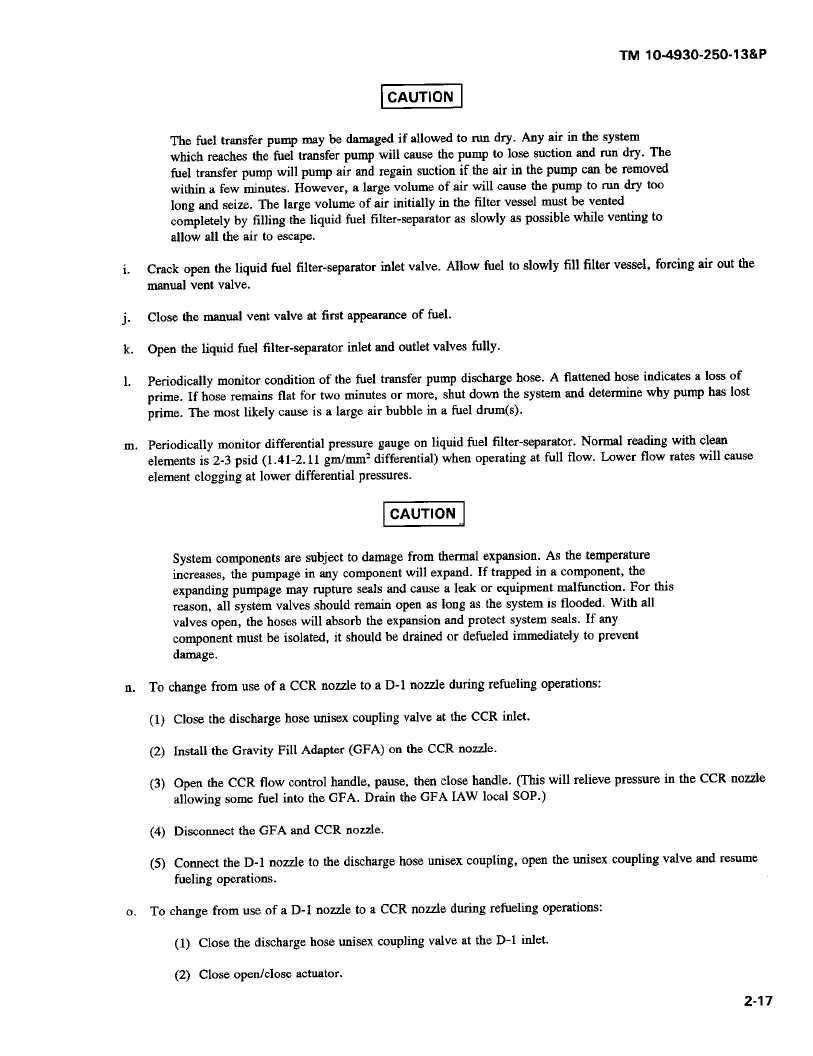|
| |
TM 10-4930-250-13&P
Thefueltransferpumpmaybedamagedif allowedto randry. Anyair in thesystem
which reaches the fuel transfer pump will cause the pump to lose suction and run dry. The
fuel transfer pump will pump air and regain suction if die air in the pump can be removed
within a few minutes. However, a large volume of air will cause the pump to run dry too
long and seize. The large volume of air initially in the filter vessel must be vented
completely by filling the liquid fael filter-separator as slowly as possible while venting to
allow all the air to escape.
i.
Crack open the liquid fuel filter-separator inlet valve. Allow fuel to slowly fill filter vessel, forcing air out the
manual vent valve.
j..
Close the manual vent valve at first appearance of fuel.
k.
Open the liquid fuel filter-separator inlet and outlet valves fully.
1.
Periodically monitor condition of the fuel transfer pump discharge hose. A flattened hose indicates a loss of
prime. If hose remains flat for two minutes or more, shut down the system and determine why pump has lost
prime. The most likely cause is a large air bubble in a fuel drum(s).
m.
Periodically monitor differential pressure gauge on liquid fuel filter-separator. Normal reading with clean
elements is 2-3 paid (1.41-2. 11 gm/mm2 differential) when operating at full flow. Lower flow rates will cause
element clogging at lower differential pressures.
System components are subject to damage from thermal expansion. As the temperature
increases, the pumpage in any component will expand. If trapped in a component, the
expanding pumpage may rupture seals and cause a leak or equipment malfunction. For this
reason, all system valves should remain open as long as the system is flooded. With all
valves open, the hoses will absorb the expansion and protect system seals. If any
component must be isolated, it should be drained or defueled immediately to prevent
damage.
n.
To change from use of a CCR nozzle to a D-I nozzle during refueling operations:
(1) Close the discharge hose unisex coupling valve at the CCR inlet.
(2) Install the Gravity Fill Adapter (GFA) on the CCR nozzle.
(3)
Open the CCR flow control handle, pause, then close handle. (This will relieve pressure in the CCR nozzle
allowing some fuel into the GFA. Drain the GFA IAW local SOP.)
(4) Disconnect the GFA and CCR nozzle.
(5)
Connect the D-1 nozzle to the discharge hose unisex coupling, open the unisex coupling valve and resume
fueling operations.
o. To change from use of a D-1 nozzle to a CCR nozzle during refueling operations:
(1) Close the discharge hose unisex coupling valve at the D-1 inlet.
(2) Close open/close actuator.
2-17
|

